PHOTOS: ALASKA BEAR WATCHING
One of the best decisions we made in selecting day trips in Alaska was choosing the folks from Emerald Air  from Homer to guide us on a unique Bear Watching trip. Chris & Ken, a husband and wife pair who serve as guide and pilot respectively took us along with seven other  tourists to Hallo Bay to get a close look at the brown bears or grizzly bears in Alaska. It was an once in a lifetime experience and it will be the bar against which we will measure any future animal watching trips.
 |
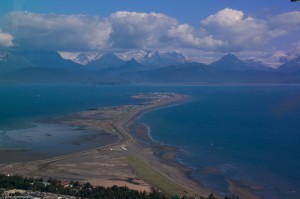 |
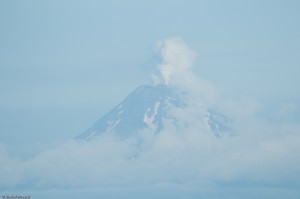 |
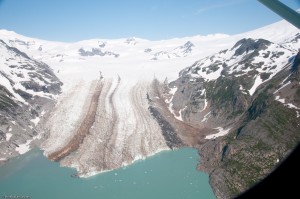 |
First thing in the morning,  Chris gave us a brief orientation on bear behavior and gave us some basic instructions on how to behave (no sudden movements, move in a group, make noise to let the bears know your presence) so we could get as close as possible to the bears. We started from Homer in a float plane piloted by Ken; it was about an hour’s trip to reach Hallo Bay.  Hallo Bay is part of the Katamai National Park, on the west side of Alaska. An aerial view of any part of Alaska is amazing and this was no different. As we were in the air, Ken pointed out a smoking volcano, a few glaciers and the city of Homer—it really seemed like we were flying off to the middle of nowhere.  I later realized  Katamai National Park truly qualifies as the middle of nowhere. We landed in water, about a hundred yards from the beach. There is no roadway to get to Katamai Island from the rest of Alaska , you can only fly or take a boat to the island,  so there is no human inhabitation on the island. It is true wilderness out there and animals such as bears roam free.
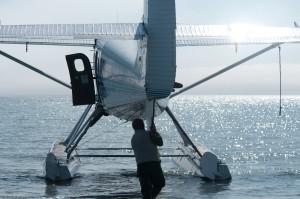 |
 |
 |
 |
As we hitched up our hip-boots (courtesy of  the Emerald Air people) and waded our way to the island, we were greeted by a almost a half a dozen bald eagles that were perched on the rocks almost like our welcoming committee.  All of us instantly grabbed our cameras and started clicking away furiously. By this time, some of us wanted to use the “facilities†and as there were none, Chris led us off up on the sandbank into the bushes (ladies at one side and the guys a little distance away) and we literally communed with nature. We were just about finishing our business when one of the men in group called out that he had spotted a bear coming our way. I believe I zipped up my pants in record breaking time. And there was this male brown bear sauntering off towards us. We watched as he made his way over to the beach & playfully scared the eagles off their perch by popping up suddenly behind them almost as though he wanted to shout Boo!
As we walked down the slope of the sand-bank, we couldn’t see the sea behind us anymore. In front of us was a silt and mud filled flat-land, that would no doubt be flooded during high-tides. We were suddenly  but surely in bear land. In front of us, there were a couple of bears that were digging for clams in the mud. Chris told us that the bears in hibernate through winter (up until March). At which point they wake up with two primary goals: eat and mate.    These bears are omnivores and at this time their (atleast for those bears that are found  in the Katamai region) diet is mainly grass and whatever clams they can manage to dig up.
Since this was the peak of the mating season, the males were in search of female bears that were “in heatâ€. We had the rare chance of seeing two bears actually in the middle of the mating process. We also saw a two males vying for the attention of one female who pretty much didn’t want to do anything with either one of them. One of the males was trying to get rid of the challenger – It was funny to see the other bear spread its hind legs and then swagger forward. Chris called it the John Wayne walk—according to her the bear was trying to look bigger and threatening.
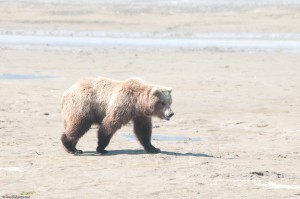 |
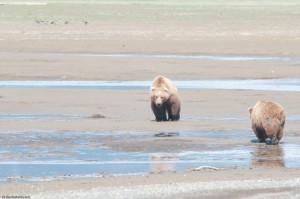 |
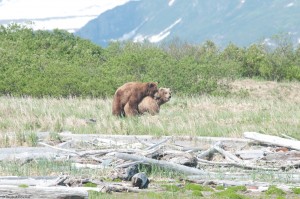 |
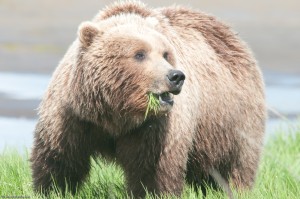 |
We left the mating bears and walked up to the  “North meadow†by this time. It was indeed a beautiful green meadow—only instead of cows or sheep grazing , there were huge brown bears. The Kodiak bears or the brown bears are bigger and fatter than the grizzly bear found in the mountains but they are essentially the same species. Due to the abundant food sources, these bears tend to weigh more (females weight between 400-700lbs and males upto 1000lbs in summer). Although the bears I could see seemed to be big powerful animals, they were actually emaciated—they would put on another 200-300 pounds before summer was over. That was certainly food for thought.  The bears were filling up on grass but the high point for the bears is in July & August when the salmon starts moving upstream to lay their eggs. The bears know exactly when the salmon run starts and prove to be excellent fishermen. They move inland towards the streams where salmon are returning to spawn and feed on them.  During those two months  they increase their body weight by about 30-40%. By the time the salmon run is over, the bears have eaten their fill and then  some to spare for the upcoming winter. It is time for these bears to head up in the mountains for the next winter. Chris also mentioned that if the females do not gain enough weight to support themselves and their offspring, the embryo does not implant. After implantation (which can be upto 6 weeks post mating), the gestation lasts about 2 months. The females wake up in the middle of the winter, give birth and simply continues to hibernate till Spring while  the newborn cubs survive on their mother’s milk.
 |
 |
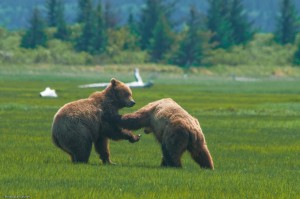 |
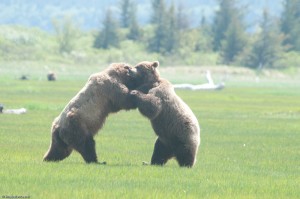 |
There were two younger bears gamboling away — a picture perfect representation of two playful teddy-bears.  By this time, we were all ready for lunch. We sat ourselves down on some driftwood logs & ate the sandwiches we had brought with us (all of us carried our own lunch). By the time we finished eating and cleaning up after us (Chris was very strict about “leaving no trace behind”) , more and more bears had joined the gathering. One bear decided to cool off in the tiny stream that was flowing near the meadow—he simply waded into the middle of the water and lay down peacefully.  We started walking across on the far side of the meadow. Chris remembered that a particularly friendly bear (she had named this one Molly) was in that area the previous day. We found Molly there—peacefully chewing on the grass. Chris picked off stalks for us to bit into—it tasted like cilantro! The trick in getting close to the bear was not to invade his/her personal space. We would walk a few steps closer (always staying behind Chris) and then stop to let the bear adjusted to our presence. If the bear continued what it was doing, then we moved a few more steps closer. If at any time, the bear seemed uncomfortable (stopped its activity and looked at us , or tried to move away), we immediately stopped. Using this tactic , we managed to get as close as about 30 feet from the bear. It was an awesome sight— these majestic animals supremely indifferent to the 9 people gawking at them and clicking away pictures like a paparazzi stalking a Hollywood celebrity .
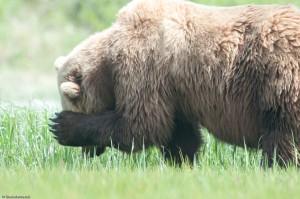 |
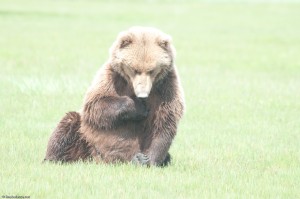 |
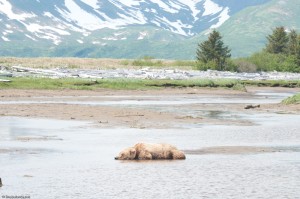 |
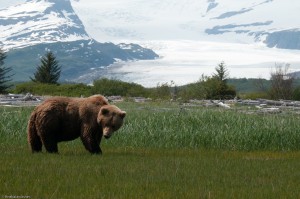 |
It was a beautiful day: the weather cooperated, the bears came out to play, the setting  couldn’t be more perfect – a beach near a green meadow surrounded by glacier capped mountains. We spent around 5 hours with the bears (with an hour’s flight each way). On our way back— Ken pointed some whales that we could see from the sky. We were tired, elated and content. We had debated about this  excursion as we were planning the trip— and wondered if it was worth the high expense and the answer was a resounding Yes!. And as I mentioned to Chris later— it brings a new awareness to the importance of conservation— seeing the bears in their natural habitat made me feel very strongly about preserving it for them and for us to enjoy watching these beautiful animals, undisturbed in their natural habitat.
This day had another distinction. We had dinner that night at a lovely out of the way restaurant called Homestead. It had some of the sweetest shrimp I have ever tasted and a wonderful margarita—which I especially enjoyed. I don’t remember much of the drive back to Cooper’s landing but Seejo assured me that I regaled him with songs about German castles for much of the way back. Needless to say, I categorically deny singing any song— much less about German castles.
